THE HYDRATION AND STORAGE BUYERS GUIDE
The information in this guide is based on the experience of 17 years in Aerospace and Yacht design, and 15 years as a major Triathlon bicycle retailer, including 10 years as the writer of Triathlete magazine’s ‘Cutting Edge’ column. In addition the writer conceived several World firsts, including the first One Piece Aerobar, first compact Triathlon bicycle, and first Hydration and Storage carrier for triathletes. These carriers have gone on to win over 30 World Championships in the past 25 years. He has also ridden 3,300 miles coast to coast climbing over 91,000 feet in the process, and testing gear along the way.
Most athletes know that when racing or training, it is important to have sufficient liquid and calories in order to achieve optimum performance. Often the difficulty is in determining the optimum amount of fluid, fuel mixture, energy supplements, and salt, needed. Then the question is ‘how do I carry these needs so that they can be easily accessible, and not slow me down due to increased aerodynamic drag?’ This guide will help you calculate your needs and provide proven winning information and how best to store your needs.
CHAPTER 1. YOUR BODILY NEEDS
A. FLUIDS NEEDED
Although the amount of fluid you will need will depend on many factors including your sweat rate, ambient temperature, correct level of clothing, and effort level, you will probably need between 20 and 31 ounces (600-930 ml) per hour. If you get to the point of feeling thirsty, then you may lose as much as 2% of your speed as you will start fatiguing. If you get dehydrated then you may get a headache, rapid heart rate and confusion that could jeopardize your safety. On race day you should lose no more than 1.5% with 2% as a maximum of your body weight. Remember to hydrate even on a cool day.
You can estimate your requirements in the following way.
- Weigh yourself just before starting to exercise, when exercising record how much you drink and how long you were exercising.
- When you return dry yourself with a towel and weigh yourself within 10 minutes of returning.
- Your weight should be within 1-2 pounds of your starting weight. If you lost 4 pounds then most of it would be fluid loss. Fat loss will be small, often less than 1 pound.
- So if you need to replace 3 pounds due to fluid loss, then you would need to drink an extra 3 pounds of fluid. As there are 16 ounces in a pound then you would need 3×16 = 48 ounces of fluid the next time you do that event or training session in similar conditions.
- In CHAPTER 2 we will talk more about fluid storage options for different length races, but you will probably need approximately 4-8 ounces every 15 minutes.
One final word, take your hydration very seriously but do not over hydrate as you could develop hyponatraemia which is when your blood sodium concentration is too low. We will talk more about sodium later in this guide.
B. CALORIES NEEDED
The calories required for a specific event will vary considerably according to the quantity of food you have eaten prior to the event, how rested you are, and how consistent your training sessions have been.
There are several ways to estimate your calories used on the bike.
- Use a web based estimator such as this www.everydayhealth.com/Calories-Burned-Biking.htm
- Use a Heart Rate Monitor that shows calories burned.
- Use the Workout calculator on www.MapMyRIDE.com
- Use a power meter if available.
You will quickly see that a person can burn around 700 calories per hour at 15 mph, and over 1000 calories per hour over 20 mph depending on their weight, gender, and age. Although some research suggests you can only absorb around 500 calories per hour, you can train your body over time to absorb more calories per hour.
Important considerations.
- Your calories can come from carbohydrates, protein and fat. A ratio of 4 Carbohydrate grams to 1 Protein gram is popular with many longer distance triathletes. One gram of carbohydrates or one gram of protein provides 4 calories of energy. One gram of fat provides 9 calories of energy.
- You will need to take in the right amount of calories and electrolytes per hour. So you will have to add up your totals from the sports drink, gels, bars, chews, waffles, powders and other fuel you may carry.
C. ELECTROLYTES NEEDED
The subject of electrolytes is extremely complex and rather than paraphrase from some of the papers on the subject, I think it is prudent to refer to a specialist who is a chemist and serious athlete and whose sole business focus is electrolytes for athletes.
Electrolytes, including sodium, potassium, magnesium and calcium, are charge-carrying entities in blood (extracellular) and inside the body’s cells (intracellular). Electrolytes play critical roles in our body’s biochemistry, including providing muscles with the ability to contract and relax, and to help transport glucose into muscle cells. Electrolyte deficiency symptoms are nausea, slower reflexes, vomiting, muscle weakness, muscle spasms, cramping, and rapid heart rate. Most athletes will benefit from a steady intake of electrolytes that are otherwise lost in perspiration and urine. While climatic conditions, athlete conditioning and individual differences place individual needs within a broad range, many athletes benefit from effective supplementation with a total of 400-1000mg of sodium per hour, along with 130-300mg potassium and smaller amounts of calcium and magnesium.
In the following link you will have sections on INGREDIENTS that covers the main ingredients lost during activity, SALT SCIENCE for understanding the issue, USAGE which will help you understand how much you need, and finally a section on POTASSIUM which is very useful. There are several suppliers on the market and we are not making a recommendation, it is just that we found this site to have the most comprehensive technical information.
www.saltstick.com/products/sscaps/cfeatures.htm
We will talk more about methods of storage in CHAPTERS 2 AND 3.
CHAPTER 2. ENERGY OPTIONS
There are many great choices on the market today. Try them all and find your favorite. You can get all of the calories from any of these options, but not necessarily all the electrolytes. You may have to take separate electrolyte tablets to supply your total electrolyte needs.
A. SPORTS DRINKS with sodium and potassium electrolytes, typically contain 160-210 calories per 24 ounce bottle, so these may not supply enough calories or electrolytes for your needs for a long race. They vary considerably in the content of Potassium with some as low as 24 mg while others have 280 mg. Check the contents and look for around 200 mg of Potassium and look for around 600 mg of sodium. The Gatorade brand has some of the best ratios.
Every person is different and the race-sponsored sports drink may not suit your digestive system. Professional triathletes often carry their own mixes of energy fluids so they can customize them to their needs and then they are not dependent on any one else on race day.
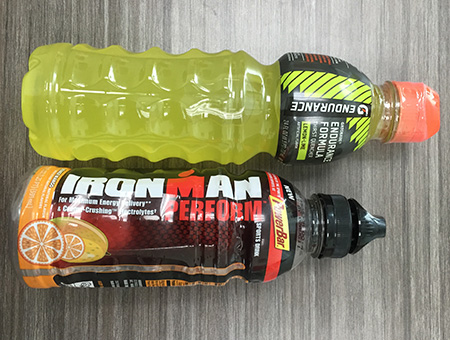
You will have to test what your digestive system can tolerate and once you find that brand, try staying with it for training and racing and carry as much of your needs as you can on race day. We will talk more on the effects of loading up your bike in the section on Aerodynamics.
B. ENERGY GELS have from 90 to 150 calories and usually have small amounts of electrolytes and a few include protein. The Sodium level varies from 30 to 230 mg and the Potassium varies from nil to 173 mg, so it is very important to ensure that you get the correct total hourly intake of electrolytes and calories. Some gels such as E-GELs have high levels of Sodium (230 mg) and Potassium (85 mg) while others only have sodium, so study the contents very carefully.
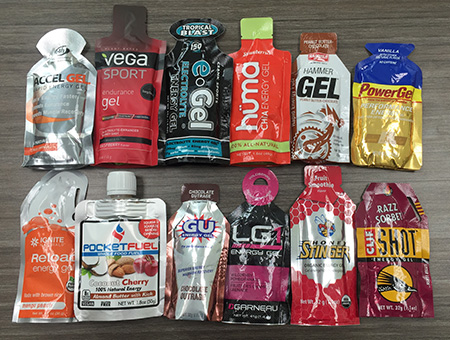
C. ENERGY BARS vary tremendously but they typically have 160-270 calories and some include protein. Some bars such as the Powerbar and Clif have good amounts of Sodium (200 mg) and Potassium (130 mg+) while others have no electrolytes at all.
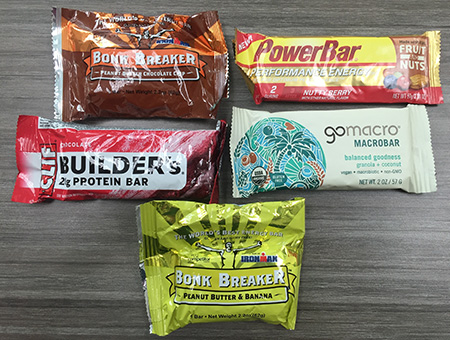
D. ENERGY CHEWS are very popular as they are not as messy as gels. Cytomax, GU and Gatorade have good levels of electrolytes and are worthy equivalents of the top gels mentioned. The only thing is that you have to put 8-10 pieces in your mouth to be equivalent to one gel…but they can be more fun to take.
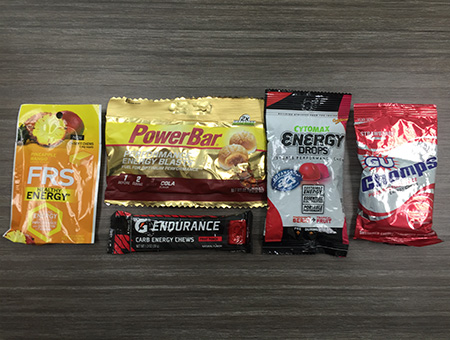
E. ENERGY POWDERS can make anywhere from 11 to 21 ozs per packet. Some athletes do add powder to refillable drink bottles while riding and then top up with water. It can be a good way of drinking the same energy mix for the whole bike split. The XLAB TORPEDO VERSAS and HYDROBLADES are one of the few bottles that has a lid so you can easily add powder while riding. Most Carbohydrate powders contain quite good amounts of electrolytes.
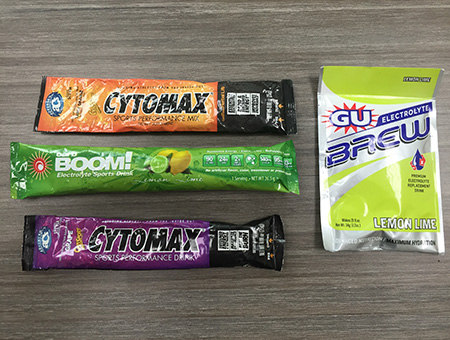
Some athletes use a combination of fuel sources including gels with Caffeine, even Coke and chocolate bars. The main thing is to get the correct totals that you need while having fun and rewarding yourself for meeting goals such as maintaining an average speed etc.
CHAPTER 3. STORING FLUIDS
The ideal method would decrease the aerodynamic drag. It would also be lightweight, and easily accessible.
FLUID STORAGE
The question is front, frame or rear, or a combination? The answer depends on the race or training session length.
1.FRONT MOUNTED BOTTLES. There are two types of front bottle, vertical or horizontal.
Vertical bottles have been mounted between the aero bars for over 20 years. They offer access to 20 to 30 ounces of fluid. Most of these types of bottles can be refilled while riding. Costs range from $20 – $100. Vertical bottles make drinking very convenient and eliminates reaching down to the frame for a bottle. Many can also be used on bicycles without aero bottles like road, e-road, mountain, hybrid and e-mountain bicycles.
Horizontal bottles have become very popular in the past few years due to XLAB introducing several versions of their TORPEDO MOUNT into the marketplace in 2009. In fact, both male and female winners of the Ironman World Championship race used horizontal bottles. Horizontal bottles have an advantage because they are shielded from the airflow by the rider’s forearms from the side, and shielded by the hands from air directly in front. Horizontal bottles, if positioned at the correct height and are at least 9 ½” long, will actually reduce drag and save up to 142 seconds on a full distance race.
Tip: Many cyclists will set an alarm for every 15 minutes and drink the amount that they calculated.
2.FRAME MOUNTED BOTTLES
Standard water bottles versus aero bottles.
Standard water bottles are nearly 3 inches in diameter and an aero frameset down tube is often only 1 ¼ inches wide so adding standard bottles in the frame increases the frontal area of the bike. You can use slimmer aerodynamic bottles on the down tube that are as thin as 1 5/8 inches wide, thereby reducing the drag considerably. The XLAB Aero TT has been used by Ironman World Champions to win numerous half and full distance races. The XLAB Aero TT can save up to 64 seconds on a Full Distance race.
3.REAR MOUNTED BOTTLES.
The idea behind these systems is that you store your fluids on the rear and bring a bottle forward when needing to refill a front bottle. This design has been around for over 25 years and has been available in many different forms and with varying levels of engineering and quality. The basic principle is good as you are placing bottles and other storage items in the rider’s draft in turbulent air. However many designs cannot hold extra gear and some are located in positions that add aerodynamic drag to the bike.
IDEAL LOCATION. Over the past 25 years we have been refining the precise zero drag position for rear hydration carriers. To do this we needed more than a wind tunnel for the reasons indicated above. Having had over 30 years of sailing experience we came up with the idea in 2006 of applying wool tufts as used on racing sails to determine the exact flow pattern of air over a rider.
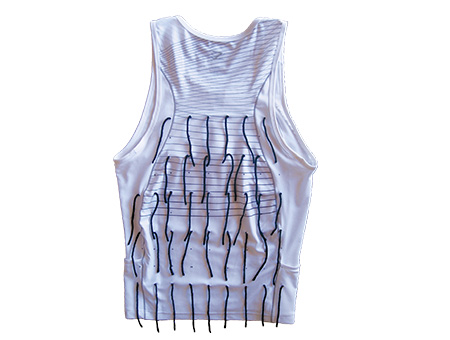
With the method we developed, using the XLAB Slipstream Vest, we were able to determine the precise position. We do not believe that any other manufacturer making rear systems has done the extensive testing with a tufted vest to find the optimum position for rear systems. XLAB is the specialist when it comes to rear systems. Our CFD image below shows typical airflow behind a triathlete at 25 mph. Rear single and two bottle XLAB Systems are designed using CFD (Computational Fluid Dynamics) to place the bottles in the optimum position for maximum drag savings.

We also found that it was important to allow the air that flows between the legs to travel cleanly around the aero seat post. Designs that placed the bottles below the saddle had much higher drag. So how high can the bottles be behind the rider? If you study photos of triathlon champions in their aero position, you can often see their race number lifting off of their back, an indication that the airflow has already separated. This is often the upper limit of the separated airflow, and as high as you should have bottles. However you do not need to go this high. Today XLAB uses CFD technology to optimize carrier position.
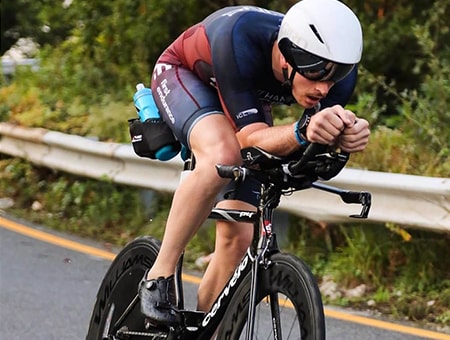
Basically you want the air to flow cleanly under the saddle. We have found that 24 ounce bottles are a good height for rear systems, but you can also use smaller or taller bottles. XLAB DELTA single bottle rear systems can save up to 129 seconds on a Full Distance race.
HIGH-GRIP CAGES. Rear systems have been criticized for launching water bottles. In fact, it is not the system that launches the bottles; rather it is the ineffective bottle cages that are being used by some riders. XLAB developed the first and only bottle cages specifically designed with the high-grip (10 lbs) required on rear systems. The XLAB Gorilla cages have a grip force that is very closely controlled and due to the unique design makes them ideal for fitting on rear systems from any company. There is also the XLAB Gorilla XT Cage with the grip force of (14 lbs) for Mountain bikers or really rough roads. The Gorilla Cages have been chosen by more World Champions, Pros and Age Groupers than any other cage for rear systems.
Summary on rear systems
- Hides in the rider’s wind shadow for the fastest way to carry fluids and reduces overall drag.
- World champion’s tunnel testing repeatedly confirms XLAB rear systems are the fastest.
- Unlike frame mounted and front vertical bottle hydration systems, rear systems are less affected by side winds.
- Stiff aerospace design and carbon fiber or aircraft alloys eliminate side sway.
- Unique cages help prevent bottle launching.
- Prices start at under $40 and go up to $260 for a Pro level system with Gorilla carbon cages.
- Carry your own energy drink mix, not whatever the race organizers have on course.
- Adjustable for bottle angle and height for easy access and comfort.
- Refill or replace front bottle when convenient to you, not in the aid station mayhem.
- Extra fluids on the rear, prevents running out before next aid station.
- Carrying your special needs eliminates stress over someone else taking your special needs bag on long races.
- XLAB Rear Systems can save up to 129 seconds on a Full Distance race
CHAPTER 4. STORAGE OF GELS, BARS, SPARE, TOOLS AND CO2S
This is always a problem on a racing bike. The nutrition items need to be very accessible and if you get a flat you want to fix it fast.
1. GELS AND BARS.
The most convenient place is on the top tube hiding in the stem’s draft. The bag should not be wider than the bike’s head tube. The items need to be kept cool with insulation and the bag needs to have an internal pocket in a contrasting color so that small items like electrolyte tablets can be easily found. The interior of the bag needs to be light in color so in a split second you can see the contents you are looking for. The zipper needs to slide with ease. The bag should have a non-slip material underneath and in front so it does not have a tendency to tip sideways. The front should be at an angle of 72 degrees so it can fit tight up against the back of the stem. Such bags do exist and XLAB has a range of 7 top tube bags. Top tube bags reduce stem drag and can save up to 135 seconds on a Full Distance race.
2. SPARE, TOOLS AND CO2S.
If you are not using a dual carrier with XLAB bags, then you may be using a single DELTA rear system. Either add the XLAB Multi-Strike Repair Holder to carry your repair kit or the XLAB AERO POUCH 300 if you have a metal rear mount like the Delta 400, Delta 425 or Delta 430.
3. ELECTROLYTE STORAGE.
Keep your tablets in an XLAB aero bag. If you do use a top tube bag, ensure it has a separate compartment and if you are right handed then choose a bag with the pocket inside on the left as it makes it much easier to access.
CHAPTER 5. GEAR SELECTION FOR SPECIFIC RACE LENGTHS
For our recommendations on equipment for Sprint, Olympic, Half and Full distance races click on SET UP GUIDE in the top menu bar of this website. This will give you several options to suit your personal needs.
SUMMARY
Whatever equipment you choose, ensure that it comes from a company that specializes in that type of product, not a company that is diverse in its offering. Ensure the company’s products have race proven winning results for at least a 10-year period and finally check on their Customer Service reputation. Good luck and we hope that this guide will help you in your choice of Hydration, Repair, and Nutrition Storage equipment.
Craig V Turner
Founder and Chairman.
XLAB OVER 30 WORLD CHAMPIONSHIPS SINCE ‘93